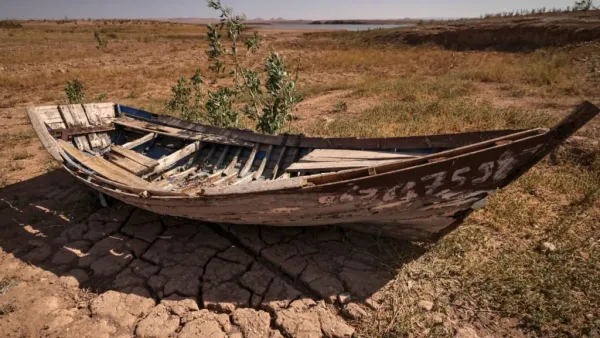Marrakesh, Morocco (TAE)-Satellite images have revealed alarming changes in Morocco's Al Massira reservoir, the country's second-largest water body crucial for serving major cities and agriculture. The dam, situated between Casablanca and Marrakesh, now holds just 3% of its water capacity compared to nine years ago.
The BBC's analysis of satellite images from March of each year starting in 2018 to 2024 shows a stark transformation of the landscape around the reservoir. Previously green areas have turned parched and beige, reflecting severe water depletion.
Professor Brian Thomas, a hydrogeologist who has analyzed these images for NASA, noted significant reductions in the reservoir’s surface area. "The images clearly depict a rapid change," he said, adding that the colour of the water has also shifted, indicative of alterations in land use and river flow.
This persistent drought, now in its sixth consecutive year, coupled with climate-induced high temperatures, has accelerated evaporation, further straining Morocco’s water resources. Agriculture, consuming nearly 90% of the nation’s water according to the World Bank, has been severely impacted.
Local farmer Abdelmajid El Wardi described the current situation as the toughest drought in history. "For me, the current agricultural year is lost," El Wardi stated, highlighting the dire conditions on his farm near Ain Aouda. He noted significant impacts on his livestock, including stillbirths among his ewes due to the scarcity of water and food.
Further impacts of the drought include the visible reduction of water in the nearby Sidi Mohammed bin Abdullah dam and enforced water-saving measures across the country. Morocco has even mandated the closure of its famous hammams, or public bathhouses, three days a week to conserve water.
In response to the crisis, King Mohammed VI has urged government officials to prioritize securing drinking water supplies. Efforts are underway to expand desalination plants, although these come with environmental costs, such as potential harm to marine life due to the discharge of salt and chemicals.
The situation has reached critical levels, with the country recording its highest-ever temperature of 50.4C last August. Experts like Dr. William Fletcher of Manchester University warn that Morocco must brace for more frequent and intense droughts as climate change progresses. "Morocco is crossing thresholds that records have never seen before," Fletcher emphasized, highlighting the pressing need for adaptive strategies to manage the country's water resources more sustainably.


Related News
Fez Echoes with the Sounds of Tariqa Raissouniya at the Moroccan Sufi Culture Festival
Apr 28, 2024
Moroccan Team Wins by Default After Jersey Seizure Sparks Diplomatic Row
Apr 25, 2024
Morocco Aims to Become a Global Aviation Hub, Attracting Major Aerospace Investors
Apr 23, 2024